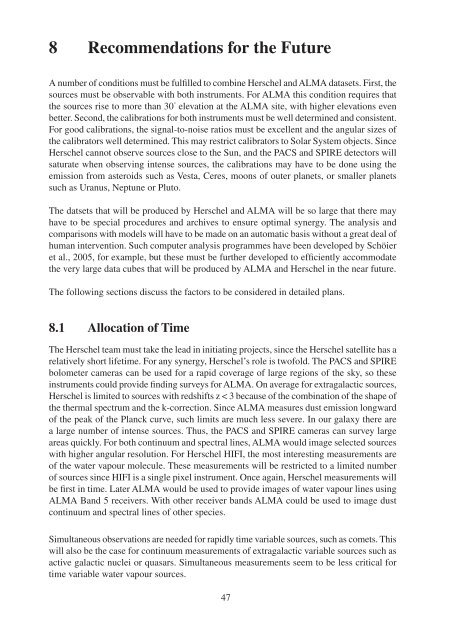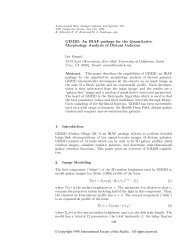4 Comparison of the ALMA and Herschel - ESO
4 Comparison of the ALMA and Herschel - ESO
4 Comparison of the ALMA and Herschel - ESO
Create successful ePaper yourself
Turn your PDF publications into a flip-book with our unique Google optimized e-Paper software.
8 Recommendations for <strong>the</strong> Future<br />
A number <strong>of</strong> conditions must be fulfilled to combine <strong>Herschel</strong> <strong>and</strong> <strong>ALMA</strong> datasets. First, <strong>the</strong><br />
sources must be observable with both instruments. For <strong>ALMA</strong> this condition requires that<br />
<strong>the</strong> sources rise to more than 30 ° elevation at <strong>the</strong> <strong>ALMA</strong> site, with higher elevations even<br />
better. Second, <strong>the</strong> calibrations for both instruments must be well determined <strong>and</strong> consistent.<br />
For good calibrations, <strong>the</strong> signal-to-noise ratios must be excellent <strong>and</strong> <strong>the</strong> angular sizes <strong>of</strong><br />
<strong>the</strong> calibrators well determined. This may restrict calibrators to Solar System objects. Since<br />
<strong>Herschel</strong> cannot observe sources close to <strong>the</strong> Sun, <strong>and</strong> <strong>the</strong> PACS <strong>and</strong> SPIRE detectors will<br />
saturate when observing intense sources, <strong>the</strong> calibrations may have to be done using <strong>the</strong><br />
emission from asteroids such as Vesta, Ceres, moons <strong>of</strong> outer planets, or smaller planets<br />
such as Uranus, Neptune or Pluto.<br />
The datsets that will be produced by <strong>Herschel</strong> <strong>and</strong> <strong>ALMA</strong> will be so large that <strong>the</strong>re may<br />
have to be special procedures <strong>and</strong> archives to ensure optimal synergy. The analysis <strong>and</strong><br />
comparisons with models will have to be made on an automatic basis without a great deal <strong>of</strong><br />
human intervention. Such computer analysis programmes have been developed by Schöier<br />
et al., 2005, for example, but <strong>the</strong>se must be fur<strong>the</strong>r developed to efficiently accommodate<br />
<strong>the</strong> very large data cubes that will be produced by <strong>ALMA</strong> <strong>and</strong> <strong>Herschel</strong> in <strong>the</strong> near future.<br />
The following sections discuss <strong>the</strong> factors to be considered in detailed plans.<br />
8.1 Allocation <strong>of</strong> Time<br />
The <strong>Herschel</strong> team must take <strong>the</strong> lead in initiating projects, since <strong>the</strong> <strong>Herschel</strong> satellite has a<br />
relatively short lifetime. For any synergy, <strong>Herschel</strong>’s role is tw<strong>of</strong>old. The PACS <strong>and</strong> SPIRE<br />
bolometer cameras can be used for a rapid coverage <strong>of</strong> large regions <strong>of</strong> <strong>the</strong> sky, so <strong>the</strong>se<br />
instruments could provide finding surveys for <strong>ALMA</strong>. On average for extragalactic sources,<br />
<strong>Herschel</strong> is limited to sources with redshifts z < 3 because <strong>of</strong> <strong>the</strong> combination <strong>of</strong> <strong>the</strong> shape <strong>of</strong><br />
<strong>the</strong> <strong>the</strong>rmal spectrum <strong>and</strong> <strong>the</strong> k-correction. Since <strong>ALMA</strong> measures dust emission longward<br />
<strong>of</strong> <strong>the</strong> peak <strong>of</strong> <strong>the</strong> Planck curve, such limits are much less severe. In our galaxy <strong>the</strong>re are<br />
a large number <strong>of</strong> intense sources. Thus, <strong>the</strong> PACS <strong>and</strong> SPIRE cameras can survey large<br />
areas quickly. For both continuum <strong>and</strong> spectral lines, <strong>ALMA</strong> would image selected sources<br />
with higher angular resolution. For <strong>Herschel</strong> HIFI, <strong>the</strong> most interesting measurements are<br />
<strong>of</strong> <strong>the</strong> water vapour molecule. These measurements will be restricted to a limited number<br />
<strong>of</strong> sources since HIFI is a single pixel instrument. Once again, <strong>Herschel</strong> measurements will<br />
be first in time. Later <strong>ALMA</strong> would be used to provide images <strong>of</strong> water vapour lines using<br />
<strong>ALMA</strong> B<strong>and</strong> 5 receivers. With o<strong>the</strong>r receiver b<strong>and</strong>s <strong>ALMA</strong> could be used to image dust<br />
continuum <strong>and</strong> spectral lines <strong>of</strong> o<strong>the</strong>r species.<br />
Simultaneous observations are needed for rapidly time variable sources, such as comets. This<br />
will also be <strong>the</strong> case for continuum measurements <strong>of</strong> extragalactic variable sources such as<br />
active galactic nuclei or quasars. Simultaneous measurements seem to be less critical for<br />
time variable water vapour sources.<br />
47




